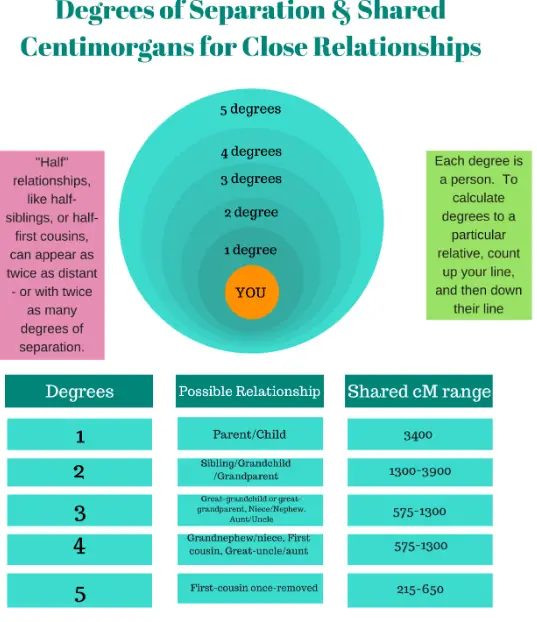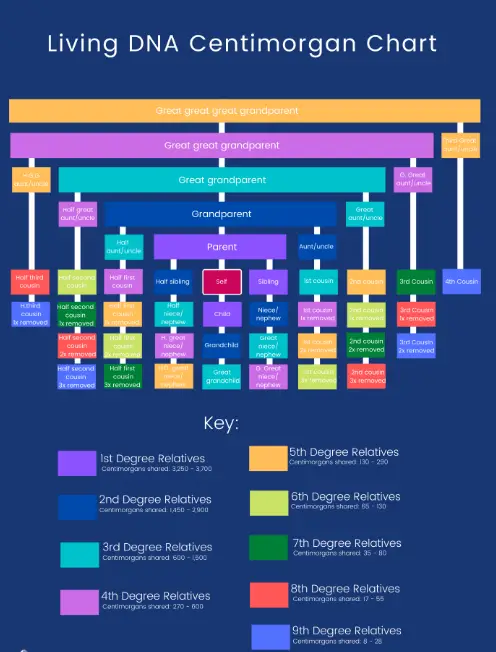Genetic linkages play a pivotal role in understanding hereditary conditions and tracing lineage through generations. DNA segments and centimorgans are two crucial terms frequently encountered in the study of genetics, each serving as measures of genetic relationships and heritage. Despite their common use in genetic analysis, the distinction between these two measurements is often unclear to those outside of the genetic sciences.
DNA segments refer to the actual physical sections of DNA that are compared for genetic similarities or differences, while centimorgans measure the probability that a segment of DNA will crossover from one generation to another. Essentially, while DNA segments are about the physical presence of DNA, centimorgans relate to the genetic distance and the likelihood of inheriting specific segments of DNA.
Understanding the difference between DNA segments and centimorgans sheds light on the complexity of genetic inheritance and is essential for both academic research and practical applications in genealogy. The measurements help in predicting genetic traits, understanding genetic relationships, and exploring ancestral backgrounds, thus bridging gaps between biological inheritances and genealogical histories.

DNA Segments Explained
Definition and Characteristics
DNA segments are essential elements in the study of genetics, primarily focusing on the parts of DNA that are analyzed during genetic testing and research. A DNA segment is a contiguous sequence of DNA on a chromosome. Characteristics of these segments include their length, which can vary significantly from a few to millions of base pairs, and their locations, which are often tied to specific genes or regions within the genome.
DNA segments are identifiable through specific sequences known as markers. These markers help in comparing genetic material across different individuals to establish biological relationships and ancestral connections. The precise identification of these segments plays a critical role in determining genetic links and understanding evolutionary histories.
Role in Genetic Inheritance
In genetic inheritance, DNA segments are the vehicles through which genetic information is passed from parents to offspring. Each segment carries specific genetic codes that determine traits ranging from simple physical characteristics to more complex attributes such as susceptibility to certain diseases. During reproduction, segments can undergo mutations, which may introduce new traits or alter existing ones.
The inheritance of these segments is random, with offspring receiving a mix of segments from both parents. This combination affects the genetic diversity within a population, which is vital for the survival and adaptation of species.
Centimorgans Defined
Historical Context and Origin
The term centimorgan was introduced to honor the American geneticist Thomas Hunt Morgan, who pioneered the use of fruit flies to study genetic principles. Morgan’s work laid the foundation for understanding genetic linkage and the recombination of genes, which are central concepts in the use of centimorgans.
A centimorgan is a unit of measure that describes the genetic distance between two positions on a chromosome. It reflects the likelihood that a single genetic crossover will occur between them during meiosis. Historically, the development of this measurement significantly advanced the field of genetics by allowing scientists to map genes based on genetic linkage rather than just physical location.
Definition and Significance
A centimorgan is defined as the distance between chromosome positions for which there is an average of 1% recombination. This metric is crucial because it provides a probabilistic measure of the distance between genes, indicating how often they are likely to be inherited together.
Understanding centimorgans is significant for geneticists as it aids in creating more accurate genetic maps. These maps are used not only in basic scientific research but also in practical applications such as disease gene identification, crop improvement, and animal breeding.
Measuring Genetic Distance
How Centimorgans Quantify Linkage
Centimorgans are used to quantify the genetic linkage in mapping studies. The calculation of centimorgans involves:
- Observing recombination rates: The frequency of recombination during cell division indicates the distance in centimorgans.
- Statistical analysis: Data from genetic crosses are analyzed to estimate the average recombination percentages between markers.
This measurement allows geneticists to predict which genes are likely to be inherited together, facilitating studies on genetic traits and diseases.
Comparison with Physical Measurements
While centimorgans provide a probabilistic measure of genetic distance, they do not correlate linearly with physical distance measured in base pairs. The relationship between these two types of measurement can vary widely across different regions of the genome and among different species. This discrepancy occurs because some areas of the genome are more prone to recombination than others.
DNA Segments vs. Centimorgans
Key Differences
The key differences between DNA segments and centimorgans lie in their nature and use:
- Physical vs. Genetic Distance: DNA segments represent physical portions of DNA; centimorgans represent genetic distances based on the likelihood of recombination.
- Measurement Units: DNA segments are measured in base pairs, while centimorgans are measured in probabilities of recombination.
Practical Implications in Genetics
Understanding both DNA segments and centimorgans has practical implications in various fields of genetics:
- Disease Research: Identifying how genes linked to diseases are inherited.
- Ancestry Testing: Determining how closely individuals are related based on shared DNA segments and their genetic distance in centimorgans.
Application in Genealogy
Utilizing DNA Segments and Centimorgans
In genealogy, DNA segments and centimorgans are tools that greatly enhance the accuracy of family history research. They allow genealogists to establish degrees of kinship and ancestral origins with a higher level of precision.
- DNA Segments: These are used to identify shared genetic material among potential relatives. When significant matches are found, it suggests a common ancestor.
- Centimorgans: This measurement helps determine the closeness of the relationship. The higher the centimorgan value shared between two individuals, the closer their familial connection is likely to be.
Case Studies and Examples
Several case studies highlight the effectiveness of these tools in genealogical research:
- Identifying Relatives: In a notable case, genealogists were able to reconnect long-lost siblings separated at birth. By comparing DNA segments that matched across their genomes, they found a significant overlap, and through centimorgan measurements, they could establish the close familial relationship.
- Ancestral Origins: Another case involved tracing the lineage of an individual back to specific European villages. By analyzing shared DNA segments with others from known geographic regions and correlating the centimorgan values, genealogists pinpointed the family’s origin to a small area in Eastern Europe.
Challenges in Measurements
Variability Across Populations
One of the main challenges in using DNA segments and centimorgans for genetic linkage studies is the variability across different populations. Genetic diversity can significantly affect recombination rates, which in turn influences centimorgan values.
- Population-Specific Recombination Rates: Different populations have unique historical and evolutionary backgrounds that alter their genetic landscapes. These differences can lead to discrepancies in how DNA segments are inherited and how centimorgans are calculated, potentially complicating genetic analyses.
Limitations of Current Methodologies
Despite the advancements in genetic testing, current methodologies still face significant limitations:
- Accuracy of Recombination Maps: The maps used to calculate centimorgans are not universally accurate for all genetic backgrounds. They are often based on specific populations, which can lead to errors when applied to individuals from other backgrounds.
- Partial DNA Segment Analysis: Not all segments of DNA are analyzed during genetic testing, which can result in incomplete or misleading information about genetic relationships and ancestry.
Technological Advances
Innovations Enhancing Accuracy
Recent technological advances are aimed at overcoming the limitations of earlier methods and enhancing the accuracy of genetic measurements:
- High-Throughput Sequencing Technologies: These technologies allow for more comprehensive analysis of DNA, covering larger segments and providing more detailed genetic information.
- Improved Recombination Maps: New methods in genetic research have led to the development of more accurate recombination maps that take into account the diversity of human populations.
Future Prospects in Genetic Mapping
The future of genetic mapping looks promising, with several developments on the horizon:
- Machine Learning Models: Researchers are developing machine learning algorithms that can predict recombination rates more accurately across different populations.
- Global Genetic Databases: The creation of extensive genetic databases that include a wide variety of genetic profiles from around the world will enhance the precision of genealogical research.
Frequently Asked Questions
What is a DNA Segment?
A DNA segment is a stretch of DNA that is used in genetic comparisons. These segments can vary in length and are significant in identifying genetic relations and ancestral links. They represent actual physical portions of the DNA molecule that are analyzed for genetic similarities.
What is a Centimorgan?
A centimorgan (cM) is a unit of measure used in genetics to describe the length of a DNA segment based on the likelihood of recombination between two genes during inheritance. It quantifies the probability that a segment of DNA will be inherited together, making it crucial for understanding genetic linkage.
How are Centimorgans Calculated?
Centimorgans are calculated based on the probability of recombination occurring between two points on a chromosome during meiosis, the process of producing reproductive cells. The higher the number of centimorgans, the greater the likelihood that two genetic markers are closely linked and inherited together.
How Do DNA Segments and Centimorgans Affect Genealogical Research?
In genealogical research, understanding both DNA segments and centimorgans helps trace lineage and determine relationships. Larger DNA segments and higher centimorgan values typically indicate closer relationships, aiding in more precise family tree constructions.
Conclusion
The nuances between DNA segments and centimorgans are foundational in the realms of genetics and genealogy. By distinguishing between the physical presence of DNA segments and the genetic likelihood represented by centimorgans, researchers and genealogists can glean deeper insights into familial links and hereditary traits. This understanding is not only critical for scientific accuracy but also enriches the stories of our ancestral past.
Embracing these measurements enhances our ability to trace lineage accurately and understand the complex tapestry of human genetics. As technology advances, the precision in measuring these elements continues to improve, promising even greater revelations in the genetic narratives we seek to understand.

